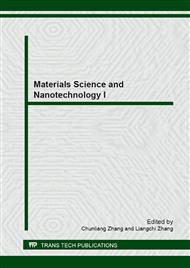p.54
p.58
p.63
p.67
p.73
p.79
p.84
p.88
p.92
Study on the Copolymer Properties of Phenolic Resin-Epoxy Resin
Abstract:
The properties of phenolic-epoxy copolymer were studied in this paper. DSC was used to detect the possibility of copolymerization between phenolic resin and epoxy resin. FT-IR monitored the reactive process of mixed resin in various temperature stages. DMA revealed that the copolymer possessed high moduli and glass transition temperatures. The result showed that phenolic-epoxy copolymer can react in appropriate proportion. It is better for the copolymer system to avoid rich epoxy without curing agent. The properties of the copolymer could be increased when sacrificed some excellent properties of phenolic and epoxy. The copolymer 70% phenolic & 30% epoxy and 60% phenolic & 40% epoxy posses higher service temperature, lower volumetric shrinkage and excellent mechanical properties.
Info:
Periodical:
Pages:
73-78
Citation:
Online since:
December 2012
Authors:
Keywords:
Price:
Сopyright:
© 2013 Trans Tech Publications Ltd. All Rights Reserved
Share:
Citation:


